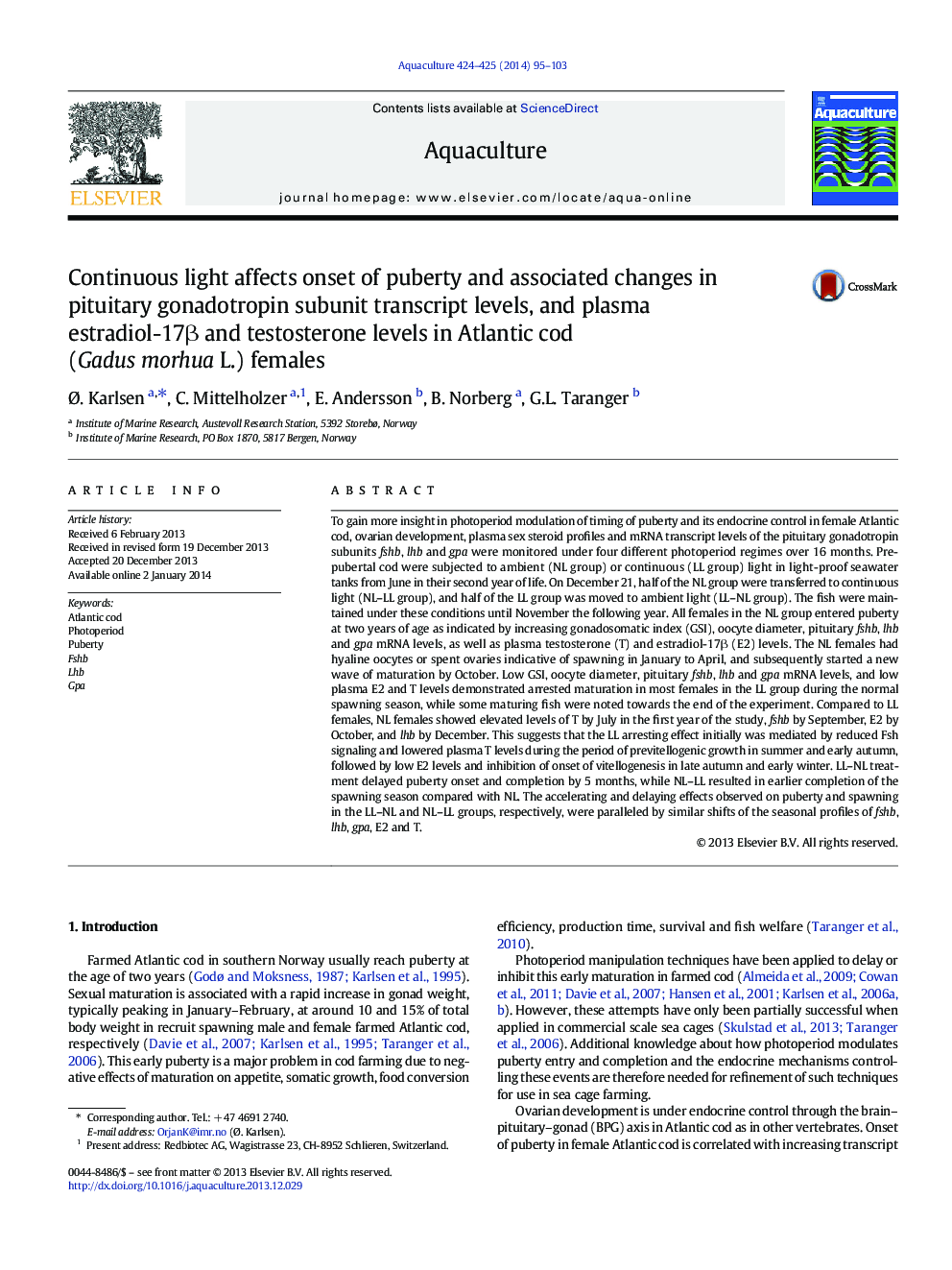| کد مقاله | کد نشریه | سال انتشار | مقاله انگلیسی | نسخه تمام متن |
|---|---|---|---|---|
| 8495252 | 1552860 | 2014 | 9 صفحه PDF | دانلود رایگان |
عنوان انگلیسی مقاله ISI
Continuous light affects onset of puberty and associated changes in pituitary gonadotropin subunit transcript levels, and plasma estradiol-17β and testosterone levels in Atlantic cod (Gadus morhua L.) females
دانلود مقاله + سفارش ترجمه
دانلود مقاله ISI انگلیسی
رایگان برای ایرانیان
کلمات کلیدی
موضوعات مرتبط
علوم زیستی و بیوفناوری
علوم کشاورزی و بیولوژیک
علوم آبزیان
پیش نمایش صفحه اول مقاله

چکیده انگلیسی
To gain more insight in photoperiod modulation of timing of puberty and its endocrine control in female Atlantic cod, ovarian development, plasma sex steroid profiles and mRNA transcript levels of the pituitary gonadotropin subunits fshb, lhb and gpa were monitored under four different photoperiod regimes over 16 months. Pre-pubertal cod were subjected to ambient (NL group) or continuous (LL group) light in light-proof seawater tanks from June in their second year of life. On December 21, half of the NL group were transferred to continuous light (NL-LL group), and half of the LL group was moved to ambient light (LL-NL group). The fish were maintained under these conditions until November the following year. All females in the NL group entered puberty at two years of age as indicated by increasing gonadosomatic index (GSI), oocyte diameter, pituitary fshb, lhb and gpa mRNA levels, as well as plasma testosterone (T) and estradiol-17β (E2) levels. The NL females had hyaline oocytes or spent ovaries indicative of spawning in January to April, and subsequently started a new wave of maturation by October. Low GSI, oocyte diameter, pituitary fshb, lhb and gpa mRNA levels, and low plasma E2 and T levels demonstrated arrested maturation in most females in the LL group during the normal spawning season, while some maturing fish were noted towards the end of the experiment. Compared to LL females, NL females showed elevated levels of T by July in the first year of the study, fshb by September, E2 by October, and lhb by December. This suggests that the LL arresting effect initially was mediated by reduced Fsh signaling and lowered plasma T levels during the period of previtellogenic growth in summer and early autumn, followed by low E2 levels and inhibition of onset of vitellogenesis in late autumn and early winter. LL-NL treatment delayed puberty onset and completion by 5 months, while NL-LL resulted in earlier completion of the spawning season compared with NL. The accelerating and delaying effects observed on puberty and spawning in the LL-NL and NL-LL groups, respectively, were paralleled by similar shifts of the seasonal profiles of fshb, lhb, gpa, E2 and T.
ناشر
Database: Elsevier - ScienceDirect (ساینس دایرکت)
Journal: Aquaculture - Volumes 424â425, 20 March 2014, Pages 95-103
Journal: Aquaculture - Volumes 424â425, 20 March 2014, Pages 95-103
نویسندگان
Ã. Karlsen, C. Mittelholzer, E. Andersson, B. Norberg, G.L. Taranger,